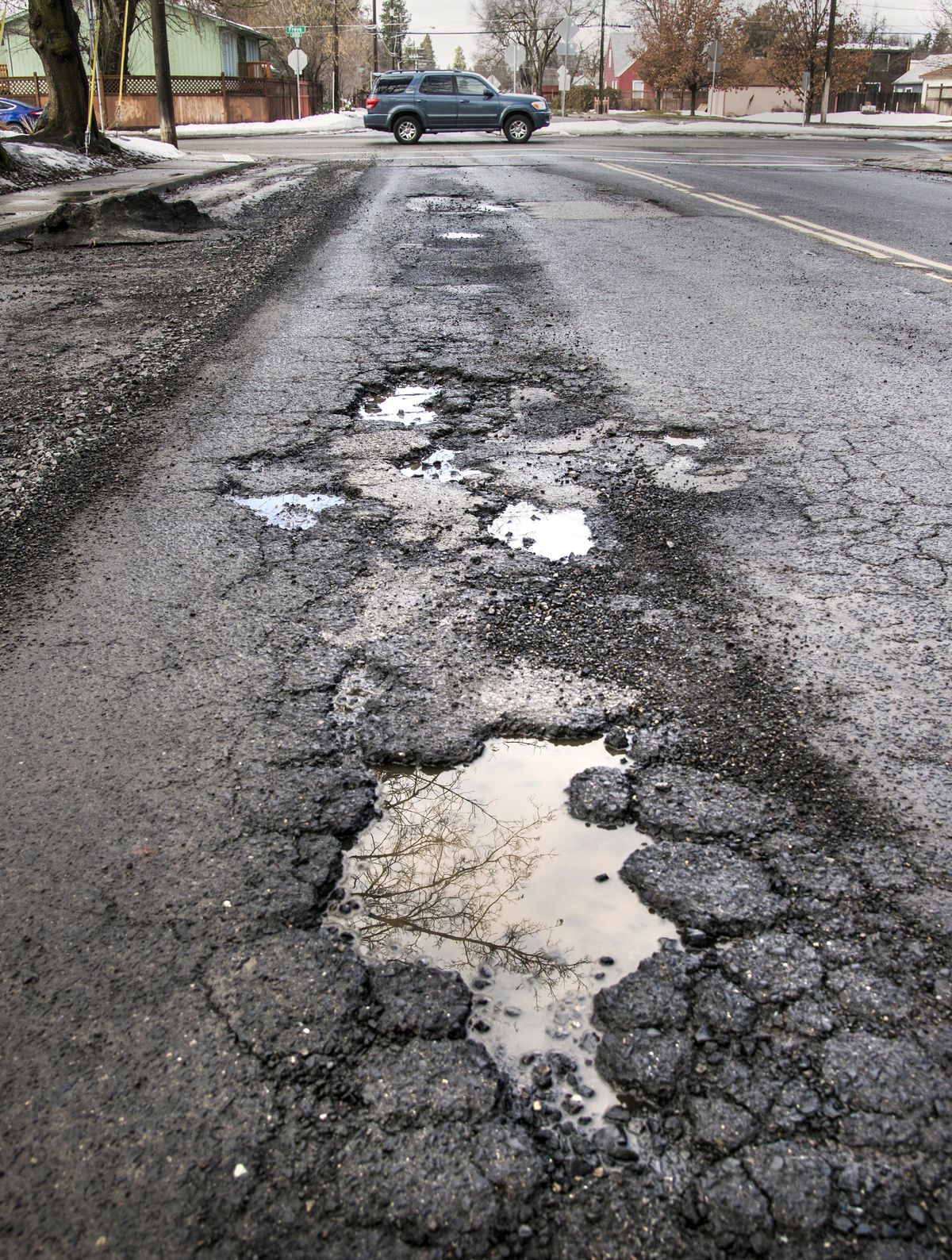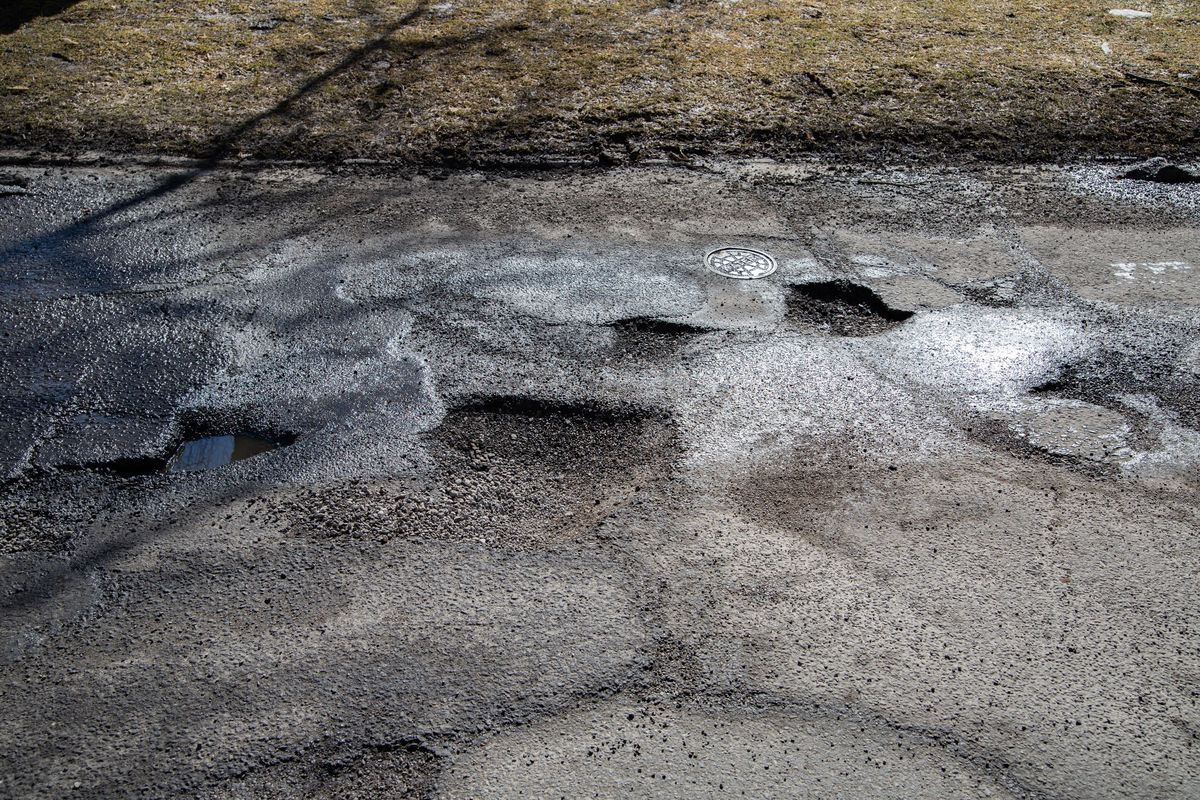Getting There: High-tech mapping of potholes will help city manage streets

Snowmelt reveals many things.
The first crocus, tulips and daffodil blossoms of spring. The trash and dog poop that people left behind, thinking somehow the snow would make those left-behinds magically disappear.
And potholes. Lots of potholes. In 2018, the city filled 4,610 potholes. The year before that, it repaired 4,795 potholes. This year, so far, the city has filled 1,392 potholes.
All that work amounts to about $500,000 a year in pothole repair. That figure doesn’t include the cost of full street maintenance projects, such as grind and overlay, or complete road rebuilds.
That money would be better spent elsewhere, said Clint Harris, the city’s street department manager. Not that he’s under the impression that the city will ever repair potholes out of existence.
“I have traveled all over the U.S. and I have yet to discover a geology that does not have potholes,” Harris said. “Will we ever not have potholes? That’s what we’d like to work to.”
On Thursday, the city made a high-tech leap toward that goal, by putting tablet computers in the hands of its pothole crew. With the fingers-crossed end to snowplow season, the pothole-focused street crews are out 20 hours a day – two crews at a time working 10-hour shifts, seven days a week. The city’s pothole crew is the first to get the tablets, which are geographic information system-enabled and outfitted with Cityworks software, a popular application that municipalities use to manage, track and analyze public infrastructure.
The idea is that when the crew repairs a pothole, it will mark its exact location on the tablet’s map, and detail how much and what type of material was used to fill it. Over time, as the city gathers this data, the city will better know where the city’s potholes are, and which streets have needed the most repair, which will in turn help determine what streets will get full rebuilds, or better maintenance than the simple refilling of a hole.

Right now, the city relies on people reporting potholes they see, by calling 311. With our world thawing out, the snow melting is less of a reveal and more of a reason for the potholes, and those phones will be ringing off the hook.
The simplest explanation for potholes is our many layered streets. An old concrete or brick street is covered with asphalt. As time goes on and temperatures swing between their summer- and wintertime extremes, the asphalt, concrete and other paving materials shrink and expand at different rates. Cracks form, and water seeps in between the layers. In the winter the water freezes, and expands, pushing the layers apart. The pavement cracks and shatters. Cars run over it, again and again.
A pothole is born.
As Harris described, there are other reasons for potholes.
It could be the pothole was last filled with “cold mix,” a type of asphalt road crews have to use in the winter when temperatures are below freezing. Unlike hot asphalt – which is heated to 300 degrees, poured in a hole and then allowed to slowly cool to form a good patch that can better withstand temperature fluctuations – cold asphalt needs a chemical binder in order to be hardened. In the end, it doesn’t have the longevity of its superheated cousin.
“The cold mix just doesn’t hold very well,” Harris said. “We’re hoping the asphalt plants will open up soon so we’ll get some hot mix in the near future. Hopefully early April.”
Or, the pothole could’ve formed because of a structural deficiency, either an error by a previous road crew or because the road was originally built for fewer vehicles.
“A lot of the streets were engineered for a lot less traffic,” Harris said. “Some of our streets are starting to incur real heavy loads. Take Market, for example. It has loads that are very consistent with Division, almost. It’s unbelievable the amount of traffic that Market is carrying.”
Market Street has seen growing traffic, but it’s not yet to Division Street levels. In 2018, about 30,000 vehicles traveled everyday on Market near its intersection with Euclid Avenue. Division saw upward of 46,000.
Regardless, Harris is confident that the city’s work, coupled with its new high-tech assistance, will put a dent in its potholes, so to speak. But as he said, they’re not going away.
As long as we have cars, we’ll have roads. And as long as we have roads, there will be potholes.
Grind and overlay? Yay!
Did someone say grind and overlay? The city of Spokane has eight street projects scheduled with this type of regular maintenance, which involves grinding away two to four inches of asphalt and laying new pavement over the existing, structurally sound road base.
The areas are:
- Freya Street from 37th to 29th avenues.
- 29th from Freya to Havana Street.
- Cowley Street from Seventh to Fourth avenues.
- Regal Street from 37th to 29th.
- Wellesley Avenue from Nevada to Pittsburg streets.
- Indiana Avenue from Division to Monroe streets.
- The Maple-Walnut couplet from Fourth to Ninth avenues.
- Hamilton Street from Trent to Sharp avenues.
The city estimates such maintenance lengthens the lifespan of the street by seven to 10 years.
Stormwater work begins again
Work on the stormwater projects in the East Central neighborhood is beginning again this week. Crews will be on Crestline Street and Pacific Avenue. Crestline will be closed between First Avenue and Pacific. The $1.75 million project is installing storm structures, a swale and related storm and sewer pipe.
Downtown, work continues on the massive, $20 million, 2.2 million-gallon stormwater tank on Spokane Falls Boulevard by the Spokane Public Library’s downtown branch. Spokane Falls Boulevard remains closed between Lincoln and Monroe.
Crews are working the final section of the service-level deck for the tank, and will begin construction of the last section of the plaza slab, which is scheduled to be poured on Saturday.
Other mechanical and electrical work is underway inside the tank.
Half of Sharp closed
The southern half of Sharp Avenue between Wall and Monroe streets will be closed through April 19. This section of Sharp, which crosses the Lincoln and Post streets S-curve just north of Arena, is easy to avoid.
The longest-lasting cars are …
The longest-lasting car in Spokane is the Chevrolet Suburban. Nearly 11 percent of Suburbans reach the 200,000-mile mark in Spokane, according to a recent study done by the automotive research company, iSeeCars.
In descending order, the other many-miled cars in Spokane are the Toyota 4Runner, Toyota Avalon, Honda Accord and GMC Yukon XL.
The study looked nationwide as well, and found that full-size SUVs lasted the longest. Nationally, the best cars for a lot of miles were the Toyota Sequoia, Chevy Suburban and Ford Expedition.
The big vehicles may be good for miles, but they’re also partly to blame for the spike in pedestrian deaths, which were up 35 percent in 2018.
The 6,227 deaths in the U.S. was the highest fatality figure in nearly 30 years, according to the Governors Highway Safety Association. The association cited the increasing use of SUVs as one of the culprits, along with the use of smartphones by motorists. According to Governing magazine, the number of SUV-related pedestrian deaths increased by 50 percent between 2013 and 2017, compared with a 30 percent increase in pedestrian deaths involving passenger cars.